There may be no other bird as unappreciated by birdwatchers as the American Coot. Among waterfowl, this much maligned bird usually elicits about as much excitement as a pile of dirt. Some birders even curse under their breath at the sight of American Coots on the water. And no wonder. The little black birds look like migratory ducks from afar. On an early, frosty morning, they can trick even the most experienced birdwatchers into raising their binoculars. The hopes of catching a glimpse of a rare migrating species on the far side of a hazy pond are so often dashed by the little white bill of this common fowl coming into focus. Another darn coot. But let’s take a closer look at this common, frustrating, yet fascinating bird.
Scientific Background of the American Coot
Coots are not ducks. They belong to the order Gruiformes in the family Rallidae, which includes rails, crakes, moorhens, and similar birds from around the world. Despite their appearance, they are more closely related to cranes than to ducks or geese. In addition to the American Coot, Fulica americana, which breeds in North America, nine other species currently live across the globe, on every continent except Antarctica. All coots belong to the genus Fulica, first named in 1758 by Carl Linnaeus.
Appearance
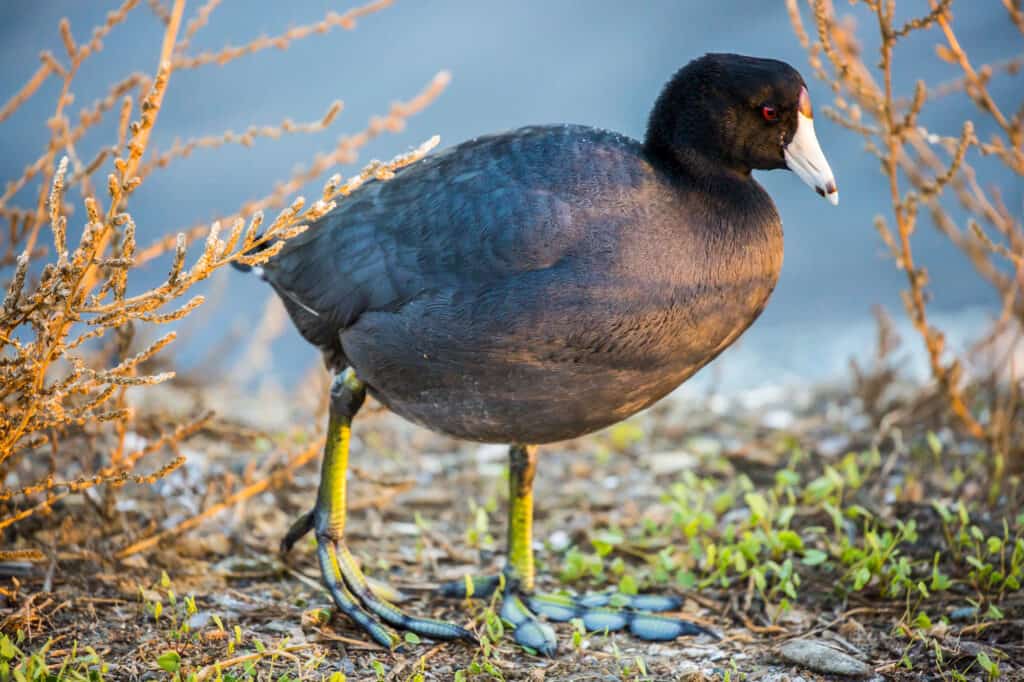
The American Coot may resemble a duck from afar, but up close there are many noticible differences.
©yhelfman/Shutterstock.com
The American Coot averages about 16 inches in length, much smaller than a Mallard and closer to the size of a small dabbling duck such as a Blue-winged Teal. Like other species in the genus, this bird has black feathers all over its body. They have a similar shape to that of a duck, with a rounded head and long neck. However, they have short wings and very short, nearly indiscernible tails.
Coots of all types have light colored bills with frontal shields that sometimes differ in color. Their bills have a rounded shape, as opposed to the flattened shape of a duck’s bill. American Coots have white bills with a black ring at the tip. They also have white frontal shields. Near the top of the shield, they have a reddish-brown spot called the callus. This spot sits slightly above and between their red eyes.
Unique Feet
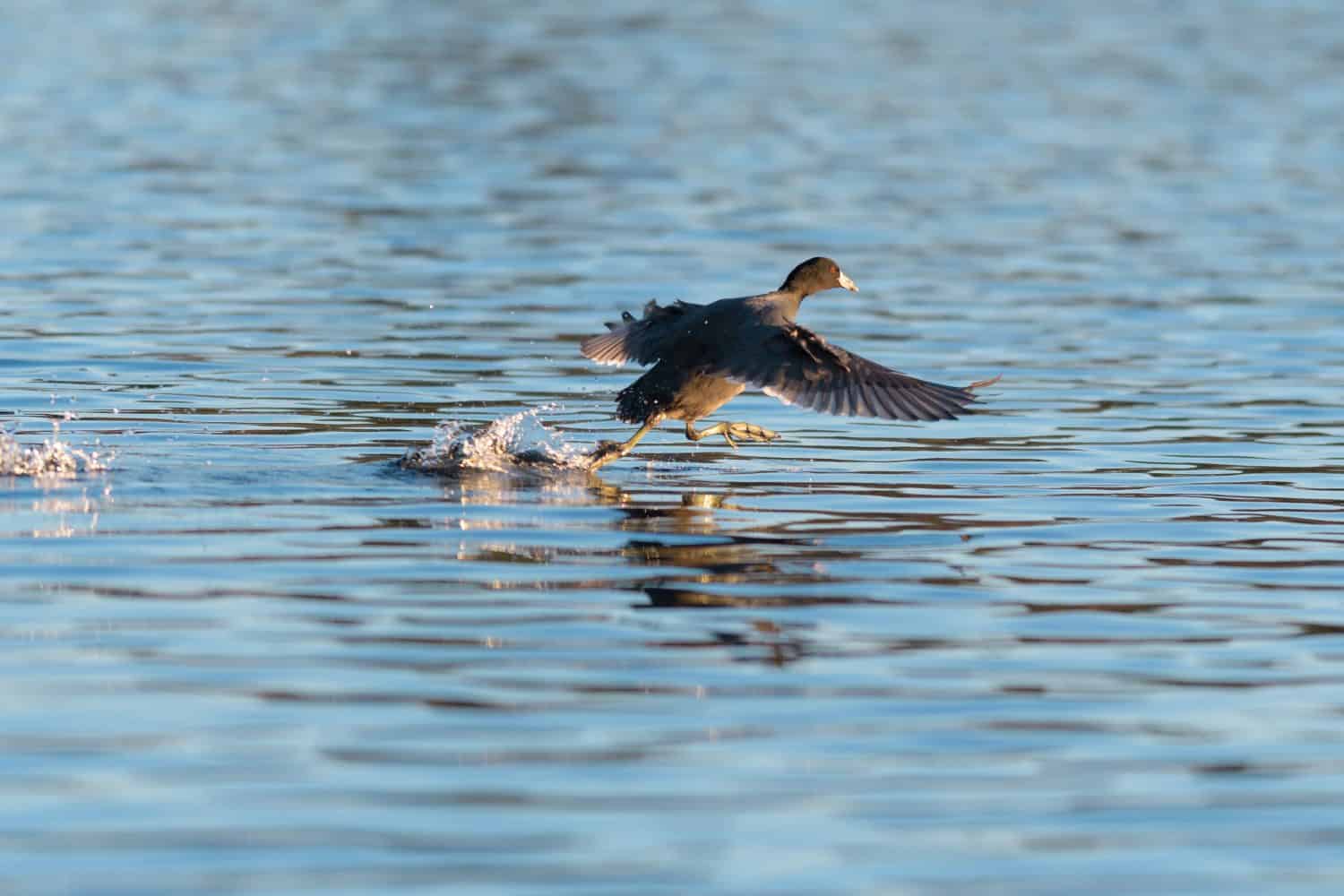
The feet of the American Coot help propel it across the water.
©2009fotofriends/Shutterstock.com
The American Coot has long, greenish-yellow legs with huge feet. These unique feet have three forward-facing, unwebbed toes, and one that faces backward. These toes each have two or three fleshy lobes that give them a segmented look. The lobes help propel them through the water and stabilize them on marshy land. They also make easily identifiable tracks.
Where Do American Coots Live?
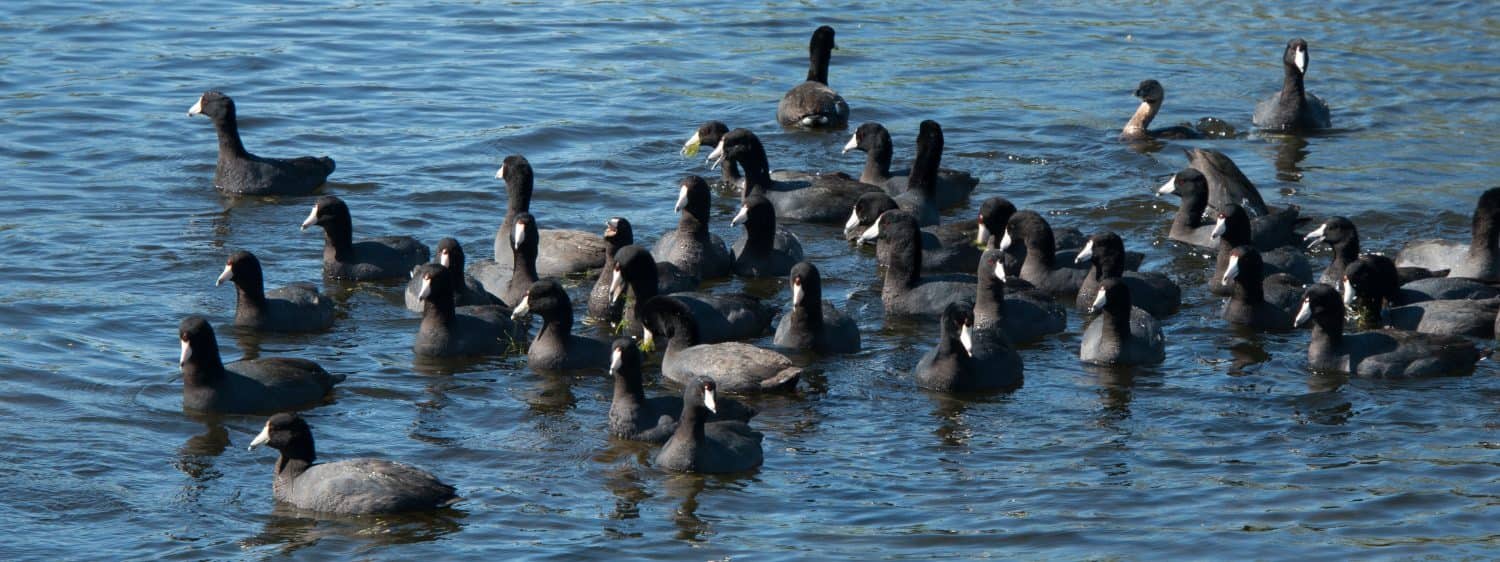
American Coots live near the water across much of North America, Central America, and the Caribbean.
©Mathew Risley/Shutterstock.com
American Coots, as their name suggests, live mainly in the Americas. They typically live near bodies of fresh water, such as lakes, ponds, rivers, marshes, and other wetlands. They will make temporary homes near salt water if necessary, particularly in the winter.
The American Coot maintains permanent residence along the Pacific coast as far north as British Columbia, and in the southern United States, mainly west of the Mississippi River. They reside year-round in much of Mexico, as well as the Caribbean, parts of Central America, and a small pocket of Colombia and the northern coast of Venezuela. The American Coot also migrates across much of North America, breeding in the northern United States and Canada in the spring, and migrating south to Mexico and Central America in the winter.
Where Do They Nest?
American Coots, sometimes called mud hens or poule d’eau, French for water hen, nest in the cover of thick reeds right on the water. These birds form monogamous pairs that tend to mate for life. They work together to build and maintain their reedy nests, which float on the water. The nests measure about 12 inches across and look like shallow baskets loosely attached to surrounding vegetation. Females do most of the nest building work. Compared to the nests of many other birds, those of the American Coot do not hold up well. A pair may need multiple nests to make it through raising one clutch, even while working diligently to repair their construction.
Reproduction
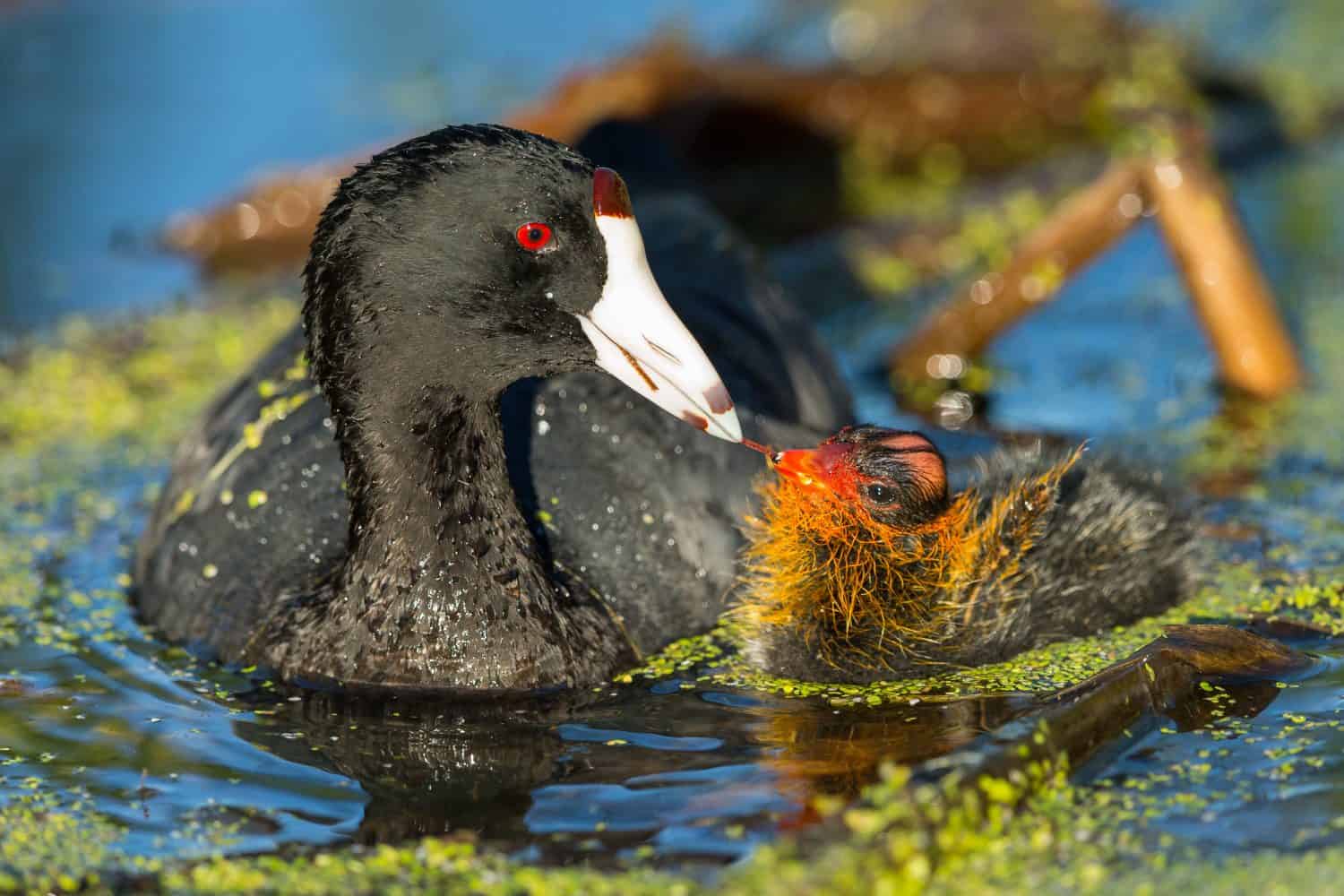
The highly ornamental features of an American Coot chick will disappear in time.
©Keneva Photography/Shutterstock.com
American Coots do not rank among the most successful breeders. They typically have one or two broods per year, and they may lay between 8 to 12 eggs per clutch. The light-colored eggs with dark speckles take from 23 to 25 days to hatch. Once the chicks hatch, roughly half of them die within the first week. This species simply produces way more chicks than they can feed, so many of those that hatch die quickly of starvation.
After that, the ranks continue to decline as the parents eliminate offspring, usually reducing the brood to just a couple of survivors. They do this through preferential feeding of certain chicks, and also through outright infanticide. Each parent chooses a favorite chick, usually one of the last ones to hatch. The favorites of the clutch are almost never the result of nest parasitism, where competing mothers lay their eggs in the nests of other coots.
All American Coot chicks have brightly colored ornamentation, including bare patches of skin on their heads and bright orange or red, spiky feathers. They eventually lose these features, but the youngest of the chicks in a brood have the brightest ornamentation, due to the way carotenoid pigments are deposited in the eggs. The brighter the chick, the more likely the parent will choose it for preferential feeding. And the less likely it will be tousled, or thrown about by the neck, and possibly killed by their parent. If an American Coot is among those lucky enough to survive, it might live 20 years or more.
Behavior
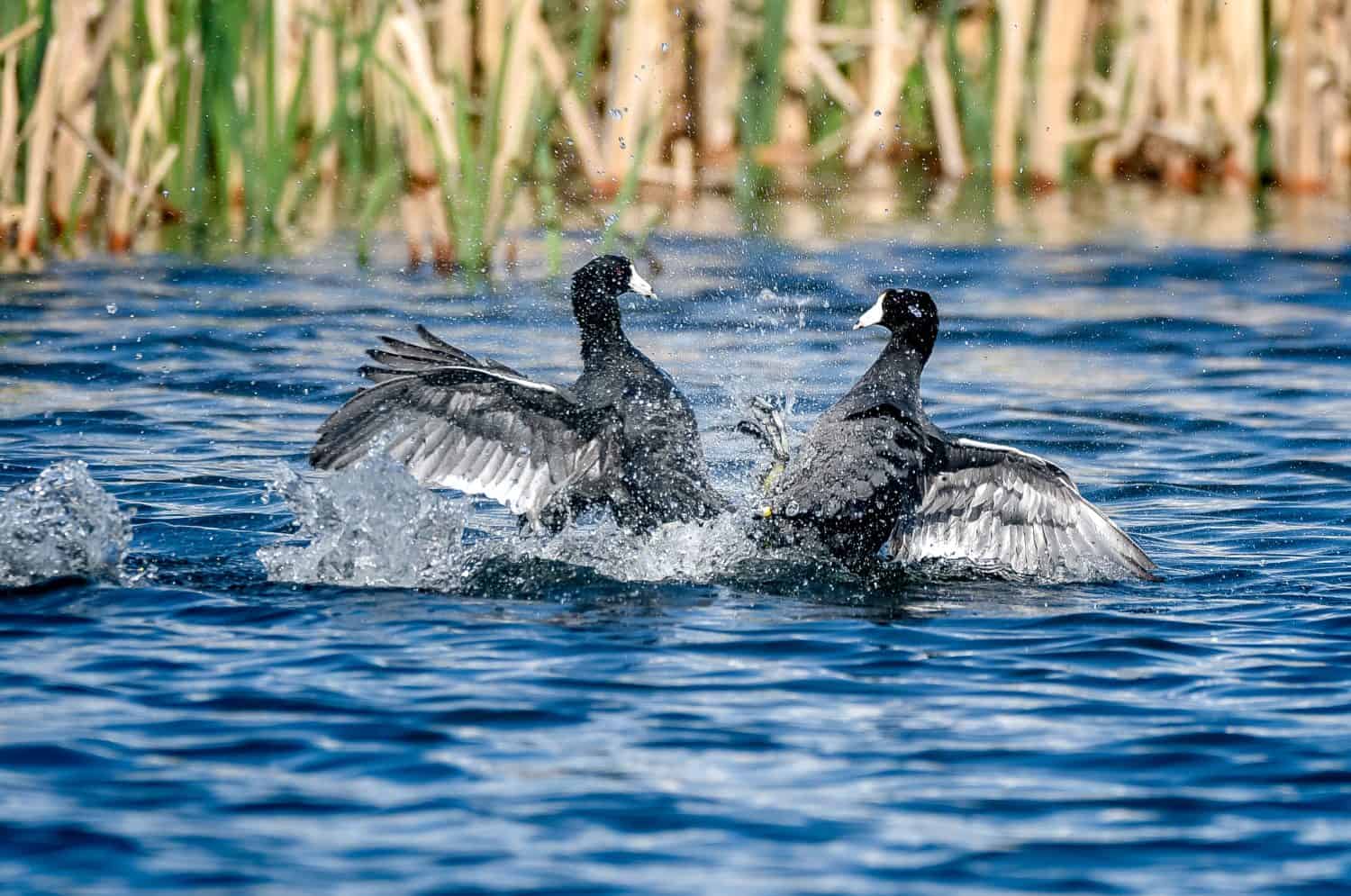
American Coots can display extremely aggressive and territorial behavior.
©Cee Pham/Shutterstock.com
Learning how ruthless American Coots can be with their offspring, it should be no surprise that they can be very aggressive and territorial birds. This species often forms large flocks, numbering up to thousands of birds when migrating. But during breeding season, pairs seek to establish and defend a territory of their own. They will attack other coots, other bird species, and even other types of animals that get too close to their nest. If a pair cannot successfully defend their territory, they may move elsewhere. Migrating individuals tend to return to the same area year after year.
Many people view American Coots as pests. Their enormous flocks can do significant damage to agricultural crops, as well as golf courses, parks, and other recreational areas. They devour native plants and crops, and they produce huge amounts of fecal material when thousands of them land and take over an area. Not only does this present an annoying and smelly situation, but the runoff can also adversely affect water quality in the area.
Diet
American Coots enjoy an omnivorous diet. The chicks consume mostly aquatic insects and other small invertebrates. As the birds get older, they eat a variety of foods, including insects, invertebrates including aquatic arthropods, fish, and other small animals. They also eat a wide variety of plants, including aquatic species and those found on land. Algae makes up a significant portion of the diet of adults.
Are American Coots Rare?
The IUCN Red List of Threatened Species lists the American Coot as a species of least concern. With millions of mature individuals, the species is not considered rare, although the population is currently declining. Threats to this species include habitat degradation and predation. Conservation efforts targeting other migratory waterfowl may benefit the American Coot as well.
The photo featured at the top of this post is © 2009fotofriends/Shutterstock.com
Thank you for reading! Have some feedback for us? Contact the AZ Animals editorial team.







